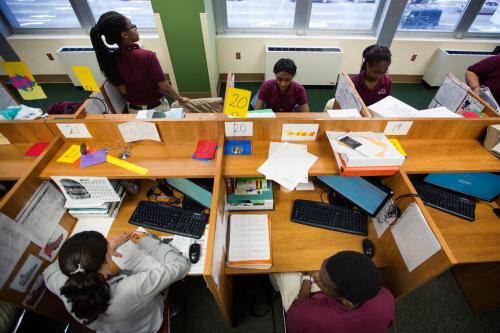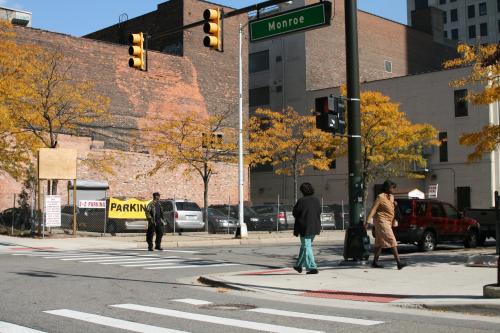As soon as the Atlanta Mayor’s race was called for Keisha Lance Bottoms on December 6, the rallying cry and social media hashtag, “My mayor’s name is Keisha,” echoed across the city and social media outlets. Not soon after initial votes were counted, a song inspired by the same theme was created, amplifying the fact that a black daughter of Atlanta, an “around the way girl,” beat the odds and her white opponent Mary Norwood to forecast a brighter future for the disadvantaged.
The slogan isn’t just a local avowal of victory; it’s an affirmation of national black social, political, and economic fitness.
You can replace the name Keisha in her motto with Latoya (Cantrell) in New Orleans, Nikuyah (Walker) in Charlottesville, Vi (Lyles) in Charlotte, and Ollie (Tyler) in Shreveport; all newly elected black female mayors. Black women’s organizing prowess even made Doug Jones the first Democrat to win a U.S. Senate seat in Alabama since 1992. With these encouraging successes in mind, portraying black women as underdogs diminishes their strength and capacity. Worse, rejecting quality black leadership evidenced by ostensive performance pumps the brakes on everyone’s progress.
Portraying black women as underdogs diminishes their strength and capacity.
To be clear, Atlanta doesn’t need a white mayor or a black mayor, man or woman, as much as the city needs leadership that fosters an economy that benefits and includes everyone. But if black representation directly correlates into economic growth among segments of the black majority who are left behind, then so be it. In actuality, Atlanta doesn’t have an economic growth problem. The problem is that not everyone is participating or benefiting from growth, particularly many black and brown communities. If cities like Atlanta are going to enhance economies to include everyone, many other racial groups (and black men) must learn how to trust black women, and by extension, trust in the principle that we’re all in this together. Otherwise, urban areas will continue to forego maximizing economic and social growth.
The election is a metaphor for what’s limiting prosperity in Atlanta.
The demarcation between precincts which voted in the December runoff for Bottoms and those which went for Norwood echoes the racial geography of the city. When the dust settled, Bottoms defeated Norwood by 832 votes in an intense battle waged across racial lines. But the election pattern doesn’t tell the full picture of what Atlanta is becoming.

From 2010 to 2016, several areas of downtown Atlanta have experienced dramatic population change. In this map of Census tracts in the city, five tracts in the downtown area decreased in black share of population by at least 22 percentage points. Over the same period, eight tracts flipped from majority-black to majority white. (By contrast, only one census tract in Atlanta shifted from majority-white to majority-black from 2010 to 2016.) Importantly, not all of these areas are in population decline. Some of these neighborhoods are losing residents (and their black populace disproportionately so), while others are growing quickly but not attracting new black residents to the area. Overall, the city is growing less black, with downtown Atlanta a complicated and important contributor to the change.
The on and off again North Atlanta effort to split Fulton County across those racial and political boundaries belie the economic growth and diversity that whites have enjoyed. Secession doesn’t represent the kind of leadership Atlanta needs or holds for the future. Not only must cities remake the traditional way they do economic development, they must rid themselves of the exclusionary practices that are the sources of low performing schools, unemployment, and substandard housing.
Exclusion is the only thing holding Atlanta back.
The Atlanta metropolitan area ranks 20th on the Brookings Institution’s latest Metro Monitor, which tracts the economic performance of the nation’s 100 largest metropolitan areas along the dimensions of growth, prosperity, and inclusion. In terms of growth, the Atlanta metro from 2010-2015 has realized an increase in the total number of jobs (14 percent), and number of jobs at young firms (13 percent), which have helped spur an increase in gross metro product by 13 percent. Not surprisingly, the computing industry led the charge in growth, but government jobs still lead the pack in the total share of jobs.
Exclusion is the only thing holding Atlanta back.
Put simply, Atlanta’s economy is generally strong. However, the range of people participating in and benefiting from the economy can improve. While the Atlanta metro ranks 47th in terms of standard of living, wages have remained stagnant. In terms of the distribution of growth and prosperity, Atlanta is 40th, with poverty declining slightly (0.3 percent). While white and Asian employment is above the national average, black employment mirrors national averages, and Hispanic employment falls below the national rate.
There are racial disparities between unemployment rates, according to Brookings analysis of 2015 American Community Survey data. Asian unemployment is 4 percent, compared to 7 percent for blacks, 9 percent for Latinos, and 3 percent for whites. Moving higher percentages of black and brown communities into high growth jobs will be the main task of Mayor Bottoms. This is an area in which black women have led by example.
Bottoms and many other black women have been elevated by their professional experiences and social networks that created opportunities when others literally tried to secede from them. Trust the black, female mayors of Atlanta, New Orleans, and Charlotte. They’ll tell you their cities don’t have leadership problems; people have issues with inclusion.







Commentary
Atlanta’s economy isn’t the problem, but a lack of faith in inclusion is troubling
January 8, 2018